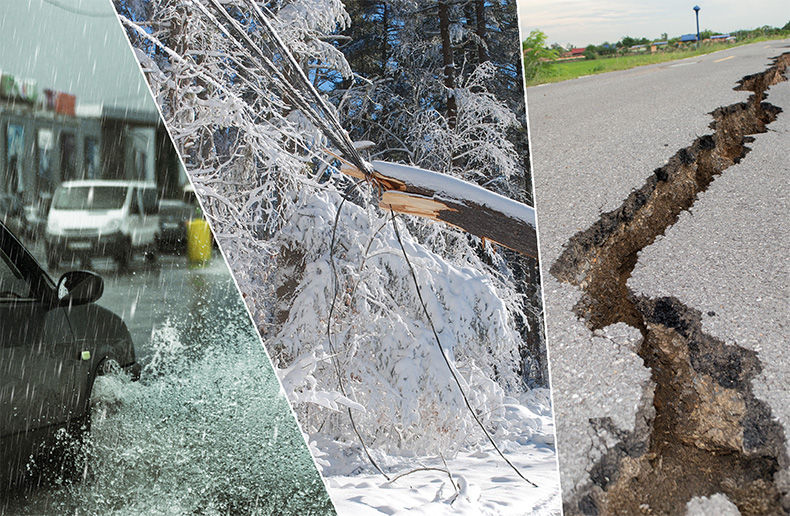Natural disasters were once again numerous and costly in 2024. Canada experienced its worst year in this regard, with four major events occurring in less than a month. These disasters alone resulted in approximately 228,000 insurance claims, reported the Insurance Bureau of Canada (IBC).
First, on July 15 and 16, torrential rains in the Greater Toronto Area caused severe flooding. Early estimates in a Morningstar DBRS report suggested the event was comparable to Toronto’s 2013 flood, predicting a cost of at least CAD 1 billion. The final bill was CAD 900 million, according to Catastrophes Indices and Quantifications (CatIQ), but another torrential rain in the same region in August added another CAD 100 million in insured losses.
Later, at the end of July, after weeks of heatwaves and drought in the Prairie provinces, an out-of-control wildfire devastated the municipality of Jasper in Alberta’s national park. The entire population and tourists were evacuated, and a third of the buildings and infrastructure were destroyed. A month later, CatIQ estimated insured damages exceeded CAD 880 million.
The third incident occurred on August 5, when an intense hailstorm struck the Calgary metropolitan area, also in Alberta. Over 130,000 claims were filed, with CatIQ’s initial estimates reporting insured losses of nearly CAD 2.8 billion. A firefighter lost his life battling the flames.
Worse than the ice storm
The final major disaster of the summer in Canada, surpassing the 1998 Quebec ice storm in insured losses, impacted the Montreal metropolitan area on August 9. The remnants of tropical storm Debby brought torrential rains. Municipal infrastructure failed to absorb the massive downpour, leading to urban flooding.
Insurers were overwhelmed by the 70,000 claims filed within a week of the event, as confirmed by two claims managers. Autorité des marchés financiers (AMF) authorized the use of temporary adjusters and raised their claims handling limit to CAD 30,000.
Remarkable weather
Environment and Climate Change Canada (ECCC) ranked the year’s top 10 weather events on December 10. The freezing cold that struck Western Canada in January ranked third, after Alberta’s wildfires and central Canada’s summer floods.
The list also highlighted unusual early summer weather, with Maritime provinces sweltering in heat while Alberta shivered. Between June 15 and 20, temperatures hit a record 37.6 °C in Bathurst, New Brunswick, while frost warnings were issued for Edmonton and Calgary. This ranked ninth on ECCC’s list.
In tenth place, Newfoundland and Labrador’s June and July wildfires forced 7,000 Labrador City residents to evacuate between July 12 and 22.
Meteorologists ranked the torrential rains that hit British Columbia in October as the fourth worst event. IBC reported CatIQ’s estimate of $110 million in insured losses for the event.
Despite these events, credit rating agencies remained optimistic about Canadian insurers’ climate-related claims.
Preliminary global report
Swiss Re Institute released a preliminary report in early December on global natural disaster losses. Losses were estimated at USD 310 billion as of December 5, with insured damages nearing USD 135 billion.
For the fifth consecutive year, insured losses exceeded USD 100 billion, according to reinsurers’ analysts.
Aon reported 11 major floods with economic damages surpassing USD 1 billion in the first nine months of the year, seven of which occurred in Asia. This did not include North Carolina’s Hurricane Helene or Florida’s Hurricane Milton-related floods.
Reinsurance Group of America noted that long-term mortality from extreme climate events remains poorly measured. Research suggested 99% of tropical cyclone deaths occur more than 21 months after the event.
Hurricanes
Tropical storms caused significant insured losses. Hurricanes Helene in late September and Milton two weeks later resulted in insured damages estimated at nearly USD 50 billion, according to Swiss Re.
The World Weather Attribution (WWA) organization attributed the severity of these hurricanes and their damages to global warming. A similar conclusion was drawn for Europe’s mid-September major floods.
Hurricane Beryl became the earliest Category 5 hurricane on record, causing damage from Texas to the Great Lakes over two weeks.
Flood risk
A Moody’s report revealed that the number of people exposed to flood risk is growing faster than the global population. Early 2024 data from Statistics Canada reported a similar trend for Canadians living along coasts.
A Morningstar DBRS analysis emphasized the urgent need for climate adaptation measures. Of Canada’s 10 costliest years for weather-related insured losses, all except the 1998 ice storm have occurred since 2011. Urban populations increasingly face torrential rains, wildfires, and violent winds.
The Intact Centre on Climate Adaptation (ICCA) at the University of Waterloo launched a tool to help municipalities reduce flood risks.
WTW published a study linking aging infrastructure to rising insured losses globally, including stormwater systems, levees, dams, and power transmission lines.
CatIQ noted that by late 2023, more Canadians had purchased flood insurance.
Earthquakes
On January 1, 2024, a 7.5-magnitude earthquake struck Japan. The United States Geological Survey (USGS) reported at least 240 deaths in Ishikawa Prefecture’s Noto region, with economic losses exceeding USD 17.5 billion.
On December 17, a 7.3-magnitude earthquake hit Vanuatu, causing significant damage in Port Vila. The epicenter was 30 km west of the capital, at a depth of 57 km. At least 18 fatalities were reported within 72 hours.
This was the 10th earthquake exceeding magnitude 7 in 2024, according to the USGS. Taiwan experienced a 7.4-magnitude quake on April 2, resulting in 18 deaths.
In autumn, ICCA published a study on Canada’s seismic risk, warning that earthquakes in British Columbia or the Quebec-Ottawa corridor could cause economic losses in the tens of billions.




